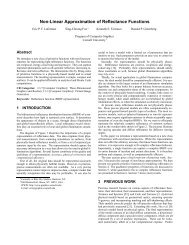pigmented colorants: dependence on media and time - Cornell ...
pigmented colorants: dependence on media and time - Cornell ...
pigmented colorants: dependence on media and time - Cornell ...
Create successful ePaper yourself
Turn your PDF publications into a flip-book with our unique Google optimized e-Paper software.
while all other light is mostly absorbed. Note that the darkening of the paint is<br />
less for the exposure under the ultraviolet filter. In order for photochemical deteri-<br />
orati<strong>on</strong> (chemical reacti<strong>on</strong>s induced by electromagnetic energy) to occur, radiant<br />
energy must be absorbed, activating the molecules. Typically, the energy of pho-<br />
t<strong>on</strong>s in the l<strong>on</strong>g wavelength (low frequency) range of the electromagnetic spectrum<br />
(infrared range <strong>and</strong> higher) is not sufficient to induce chemical reacti<strong>on</strong>s. Yet, as<br />
frequencies increase, phot<strong>on</strong>s carry more energy. Ultraviolet light, with a higher<br />
frequency (<strong>and</strong> much more energy) than that of the visible spectrum, is capable of<br />
inducing significant photochemical changes in the pigment particles.<br />
The Grotthus-Draper Law states that <strong>on</strong>ly radiati<strong>on</strong> that is absorbed by a sub-<br />
stance may cause a chemical reacti<strong>on</strong>–light must be taken in by a material in order<br />
for the energy from the light to act up<strong>on</strong> it [Fel94]. Yet, not every frequency of<br />
light elicits a change in the material. Photochemical changes are dependent <strong>on</strong> the<br />
molecular structure of the pigment particles. Sir William Bragg used the analogy<br />
to tuning forks, which are set in vibrati<strong>on</strong> when sound waves of the appropriate<br />
frequency pass through them [Bra59]. Corresp<strong>on</strong>dingly, electromagnetic energy<br />
tends to be absorbed in molecules when they are in tune with a particular frequency<br />
of incident light.<br />
If a red <strong>and</strong> a blue pigment were equally susceptible to photochemical dete-<br />
riorati<strong>on</strong>, the blue pigment would deteriorate much faster. This is due to the<br />
increased energy in the lower wavelength range of the visible spectrum (compared<br />
to higher wavelengths). However, since pigments are made of different materials,<br />
they absorb different porti<strong>on</strong>s of the electromagnetic spectrum to differing degrees.<br />
Hence, blue pigments do not necessarily deteriorate faster than red pigments.<br />
121<br />
Figure 4.17 illustrates Alizarin Crims<strong>on</strong> red fading to a colorless form due to



